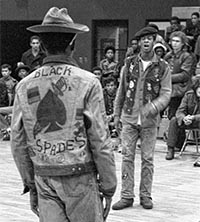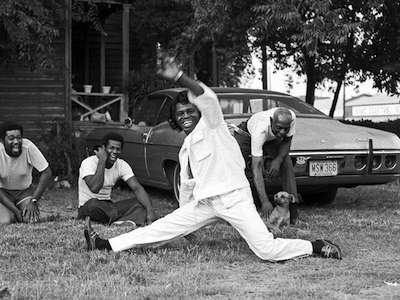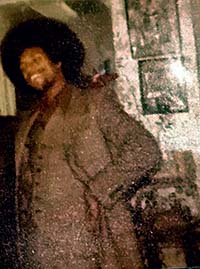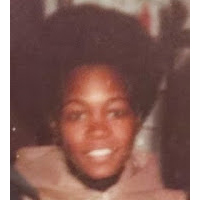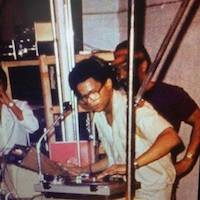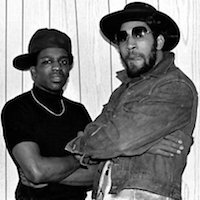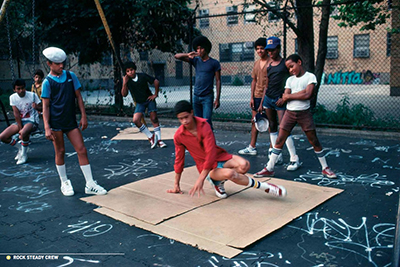
Under construction...
Breaking, also called b-boying, b-girling, or break dancing1, style of dance, often improvisational, initially developed by African-American and Caribbean-American teenagers in New York City in the 1970s. It is part of a larger cultural movement called hip hop.
Etymology and Definition
The terms breaking (informally breakin) and breaker arose in the early 1970s, while b-boy (shortened form of break boy) and b-girl were derived by DJ Kool Herc around 1974 . The terms b-boying and b-girling followed. Herc relays the etymology in the film The Freshest Kids,
In another interview, Herc elaborates, "when somebody go off in the neighborhood, 'Yo, I’m ready to break on somebody,' so we just say B-boys, you know, breakers" . Herc called his dancers "The B-Boys" . Coke La Rock recalls, "it came about later on. Me myself I think they started calling it BBoy after we had gotten to the Executive Playhouse and the Hevalo to a degree" (i.e. 1974/75). Other names for breaking (or aspects of it) included going off, the boyoiyoing or boyoing, burning, and rocking2 . The earliest written account of breaking, in 1981, uses the terms "breaking," "breaker," and "B Boy" . Banes adds that in 1980, among the members of the High Times crew, "the name hadn't crystallized [...] they referred to it as 'B-Boy,' 'rocking,' 'breaking,' or even 'that kind of dancing you do to rapping'" .
As the word "b-boy" spread, it acquired new meanings among different communities, including Bronx boy, beat boy, boogie boy, bad boy, or battle boy . The primacy of "break boy" has been disputed .
The term break dancing appeared in print no later than 1982 . By 1983, it was used as an umbrella term for multiple dance styles, including breaking, popping, and locking . Following the perceived exploitation and appropriation of the dance in the mid-1980s by "cultural outsiders" , "break dancing" developed negative connotations. It may be applied derisively to those who perform the moves of breaking but remain ignorant of the culture , or "don't dance" .
Definitions of breaking have been offered. In the first written record of the dance, Banes' explanation of breaking concludes, "most of all, breaking is a competitive display of physical and imaginative virtuosity, a codified dance-form-cum-warfare that cracks open to flaunt personal inventiveness" . Breaking has been defined in terms of its movements (e.g. toprock, footwork, power, freezes), history, music, and attitude, as well as other concepts related to the foundation of the dance . Going down to the floor has also been emphasized . A broader definition is that breaking "can be whatever you want it to be" . Ken Swift says, "physically, breaking would be dancing to the break of a song" .
The definition of b-boy or b-girl is someone who breaks . It may carry the additional connotation that they are deeply involved in hip hop culture (vis-à-vis "break dancer") . Breaker is similarly defined.
History
Precursors
Cf. Influences
DJ Smokey, a hip hop DJ in the South Bronx in the early 1970s, describes in an interview what he considers the "roots" of breaking:
The competitive, one-on-one dances done at these parties has become known as burning. Dancin' Doug estimates that it started around 1970/71, and describes it, "we would trip them or mush them or put our hats in their face after we did a spin. We started gettin' the circle then," but qualifies this with, "Burning wasn't a 'dance' all by itself. It was what people did to be creative and separate themselves from others as good dancers. Breaking was more of a dance. It evolved to that" . Cholly Rock also identifies burning as a "precursor" of breaking . Coke La Rock relates, "I wasn't a B boy, I was a dancer. I could do it all dance, play ball, fight! I can fight very well. So girls during that time use to do what we call, 'burning people up!' As they use to call it. The girls are burning people up and Herc use to come find me and say, 'Come on Coke, come and dance with her.' Herc never seen a girl burn me" . Grandmixer DXT claims, "originally, females was doing the burning" , and Doug verifies, "I used to burn guys and girls but it started with the girls" . Fuji's analysis of the "Burning Era" emphasizes the role of impressing girls,
The extent to which uprock interacted with early breaking, and the nature of such an interaction, are disputed. Popmaster Fabel writes, "some practitioners believe top rockin's first inspiration came from uprocking. The two forms developed simultaneously from similar inspirations yet kept their own identities" . King Uprock claims instead that "uprock gave birth to b-boys," having developed around 1968 . Guzman-Sanchez contends that "Uprocking blended in and became a standard part of the second-generation local B-Boy dance scene" only around 1980 and 1981, based on discussions with Trac 2 .
Elements of gang dances can be recognized in breaking, both directly and via burning and uprock. According to Cholly Rock (who was a member of the Black Spades), "much of the "burning" era was spawned by the spade dance, which involved a lot of stomping and upright spinning. It was an early precursor to us as bboys, and you will hear some old Black Spades refer to what they were doing as breaking and themselves as early bboys, but it wasn't what we were doing later on!" . Sunshine, a member of the Black Spades, recounts, "when we grew up no one was doing no—the only dance around was grinding, or whatever the dance was at the time. The twist, the jerk, or whatever, right? When we grew that's the only dances, there wasn't no break dancing. We was the only one's doing something different when it came to dancing. And we was using that in like a fighting sense [...] the context was going to a rumble; getting ready to fight. That's what it was like—to hype yourself up" . Karate Pete, another member of the Black Spades, elaborates "not just the Spades: the Seven Immortals, the Ghetto Brothers, the Savage Skulls. Everybody had their own little dance to it" . A member of the Peacemakers named Puppetmaster confirms that they had their own dance, describing it, "there would be the gestures, you understand, the waving of the hands. They might do a little spin, kick a leg out...it wasn't going on the floor at that time" . Uprock was popular among gangs as well . Marine Boy (a member of the Imperial Bachelors) says of uprock, "I gotta mention a little about the gang days, cuz that's where this all evolved from" . Papo saw members of the Ching-A-Lings rocking (with drops) in 1970/71 .
The existing party scene also had a role in the development of early hip hop DJs. As Cholly Rock recounts, "the Black Spades and other gangs hung out at clubs like The Puzzle, The Tunnel, Twilight Zone and Hevalo" . Herc's recollection, around 1970, "I was going to parties back then, see. A place called the Tunnel, A place called The Puzzle. Right on 161st St, [...] this was the first disco I used to party at, called The Puzzle. Used to have me, guys like Phase II, Stay High, Sweet Duke, Lionel 163, all the early graffiti writers used to come through [...] That was the first Bronx disco" . Jeff Chang identifies that "the Plaza Tunnel DJs had a rawer sound" than other discos , citing Hager, who wrote, "the deejay, John Brown, was the first to play records like Give It Up or Turn It Loose by James Brown and Get Ready by Rare Earth" . "People were dancing," says Herc, "but they weren't calling it b-boying. That was just the break, and people would go off" . Herc also comments on the importance of house parties he attended . Bambaataa remarks on the broader disco scene, "well before Flash, Herc, all of us, there was Disco DJs happening in the areas. Flowers, Kool DJ Jones, Lovebug Starski, and Kool DJ Dee" . Others in this group include Maboya, Plummer, and Hollywood. Of the Disco DJs, Flash cites Pete DJ Jones in particular as an influence .
James Brown's dancing has also been identified as a precursor to breaking. Bambaataa claimed, "the first form of breakdancing started with the street gangs with a dance called "Get on the Good Foot" by James Brown. There were a lot of women who was really into the breakdancing too that would tear the guys up in the early stages" , and Michael Holman wrote, "the first real breakers were the gang members of Black gangs in the Bronx in the late '60s, early '70s. These guys did a dance called the Good Foot, from James Brown's record of the same name. The Good Foot was the first freestyle dance that incorporated moves involving drops and spins and resembled the beginnings of breaking" . In fact, it is not uncommon for James Brown to be considered the first b-boy, e.g. by Kurtis Blow and Crazy Legs . Kurtis Blow also recounts, "we used to have contests, who could do the James Brown the best. Just going down to the floor and doing those splits, and doing footwork, and doing push-ups on the floor" .
Breaking does not follow a single, unbroken thread into the past. While it can be claimed that certain aspects of breaking (such as battling) to some extent "evolved" from gang dances through burning and/or uprock, early breaking can be better understood as a constellation of precursors. It is difficult to arrange such precursors into any kind of hierarchy, and the precursors also have their own complex origins. Trixie and Kurtis Blow consider themselves to have been breaking in '71 and '72, respectively . Meanwhile, according to Cholly Rock, "the b-boy—those of us who were going down on the floor spinning and all that—that is starting at Herc parties with Clark Kent, the Twins, James Bond" . Joseph Schloss articulates some aspects of the disagreement: "Does b-boying begin when rockers first drop to the floor, or when they stay there? Does a new dance happen when the style changes, or when a word is invented to describe a change that has long been established?"
First Wave (1973–1979)

Original Era (1973–1977)
As breaking began to develop, a reciprocity existed between the music and the dance—dancers responded to the music, and the DJ responded to the dancers. In an interview, DJ Kool Herc said, "the breaks was always a part of my format. Always gonna be there. Different people come there and dance to different types of music. I'm catering to each and every little group of people there. How the break thing happened, I was seeing everybody on the sidelines waiting for particular breaks in the records" . Herc had been DJing for 3 years (sometimes with his father) before he DJ'd his sister Cindy's birthday party on August 11, 1973 at 1520 Sedgewick Avenue . DJ Imperial JC describes the dancers' perspective,
The Legendary Twins' Keith offers a similar account (citing "Give It Up Or Turnit a Loose," "It's Just Begun," "Get Into Something," and "Listen to Me"), also pointing out that "Herc wasn't mixing up those parts back and forth like that at that time (at his early parties). He would put one record on and then it would play all the way through" . Indeed, many breakers remember that they would dance to the entire record, and not just the break3 . Herc would ultimately extend the break as a response to the breakers. In his words, he was "watching the crowd. Remember, that's where I come from. I come from the dancehall, I can't let them down. I can't fool around and play no wack shit. I'm watching them: the more they're having fun, the more I get busy. I told em: 'I'm a put some things together and I want y'all to check it out.' And I'm a call it the Merry Go Round" . Chang places the invention of the merry-go-round in 1973 and Hager claims that by 1975, Herc "seldom played an entire song. Instead, he just played the hottest segment of the song, which was often just a 30-second "break" section—when the drums, bass and rhythm guitar stripped the beat to its barest essence. Herc played break after break to create an endless peak of dance beats" . The music had a profound impact on the dancers—as Trixie describes it, "the beat was like a wire into my body. I would just feel the beat of the music and I just made up a dance. Boom!" , while Sasa says, "I had so much love for music and dancing that sometimes when I danced basically it would feel like my performance of a dance would come from like really the Holy Ghost. [...] I just black out from the love of it and then the love of it leads to certain moves" . Flash summarizes, "it was basically a way of expressing how the music sounds" . Cholly Rock provides a corollary, "in the early days of BBoying there were certain songs...we didn't BBoy to everything!"
Other DJs would follow Herc's example, including Grandmaster Flash, Afrika Bambaataa, Smokey, and Disco King Mario. Flash describes what impressed him,
For the earliest dancers, breaking was done mostly standing. As Flash describes it, "early breakdancing you hardly ever touched the floor. I would say, maybe this is a bad comparison, but it was more like a Fred Astairish type of thing—stylin', the hat, you know, touchin', white laces, finesse, that’s where the two intertwined. It was like just one particular couple would draw a crazy crowd in the street. Stylin', nothing sweaty, they wouldn't break a sweat. Just fly. Like Eldorado, like Mike, Sasa, Nigger Twins, Sister Boo" . The Twins' Kevin offers, "Wallace Dee, Johnny Cool, Chubby, the Amazing Bobo, James Bond, Sasa, Clark Kent, Trixie—those were the names you heard. Trixie had a big afro and used to shake his head. It used to make him look so good! Wallace Dee had a move called the slingshot, which was a basic drop to the floor except he came up like he was shooting a slingshot" . Trixie elaborates on his recognizable move, "The Trixie Shake!!!! If I shake...it was over...my whole body vibrated. From my legs.. to my chest to my head to my hair..cause I had an afro," and agrees that breaking "was done mainly on top," adding, "once you see an opening then you come down to the ground and do your rolls, your spins, all of that....but you see there is a timing for that. A lot of people the way they are breaking right now all they do is the floormoves, they are not actually dancing. No! We didn't do it like that. You danced first then you break... 'Oh Boy, you now break Boy!' Then you come back up and you dance again. It was a dance" . Wallace Dee gives an account of his style, "the finesse of the hands and the feet... the beat...it all went together. My hands went to the left and the right and my feet went to the right and the left. That's what made it look so spectacular...I always used to go with the beat and then at times I also used to freeze, you know? I used to freeze on the beat" . Doug recalls incorporating elements of the Charleston and Lindy Hop . Sasa describes his style, which included "floormoves," "I never spun on my back. If you know about James Brown that's the type of stuff I used to do but it was mine it wasn't Brown's. I made it into my stuff 'cause I added a litte different touch and whatnot. My floormoves..because I was double jointed like.. I would bend up into a pretzel...like on the floor, like a pretzel.. I come up spinning, you know?! Then I would roll into a ball, come up with a spin" . According to Coke La Rock, "[Sasa] was a cat nobody could touch, [...] he was double-jointed in his knees, which is how he came up with his drop" . Some dancers incorporated pantomimic routines, such as Sasa's Robot and Telephone Man , Clark Kent's Superman and Dracula , or James Bond's Get Smart . Fuji recalls that these routines were becomng less common, among his group, when he started breaking around 1974 .
Early breaking developed in connection with two (often fluid) contexts: battling and cyphering. The circle, or cypher, would form around (or in anticipation of) either battles or an individual dancer (or group of collaborating dancers) . Trixie describes how a battle might be initiated, "A dude would come to me and say, 'Yo Trixie! I wanna battle you!' [...] So then they would make a circle..They would make the circle big enough so that we could dance. [...] A lotta Girls is watching me DANCE too now..not just the guys...but the girls is there too!! So that would mean more guys would come at me...you know the guys would get jealous and wanna dance!" . Clark Kent describes his motivation, "we quickly ran through whoever thought they was somebody at Kool Herc's at that time. It was only a matter of time before you got on our nerves and you kept running your mouth.. and we waited until you were dancing in your little circle and I would jumped into your circle and make short work of you. That's how we got down at Kool Herc's parties. Like a lot of our stuff was never premeditated" . Wallace Dee seems to provide a more congenial account of his frequent battles with Trixie, "Every time we saw each other...and they played our songs...it was like, 'Come on, man! Let's go!'" . James Bond provides a slightly different account, "the Twins and us we used to battle a little bit but we became friends because we was all dancing for the same DJ. So it was really like different people trying to become a BBoy battling us. So it really wasn't too much of us dancing against them like me against The Twins or me against Clark Kent...it was more like a nobody trying to get up and dance against one of us. We were constantly fighting for our reputation to keep it" . Fuji notes that breaking in a circle was not always a battle, "sometimes it was just admiration for each other. Knowing each one was good and it was just about showing your skill set. It wasn't always like, "Oh, I don't like that dude! I wanna battle him!" No, it wasn't always like that! It did happen, don't get it twisted but a lot of times it was just fun and admiration for dancing" . This performative mode of breaking is recognized by Smokey, who describes the Smoke-a-Trons as "performers," as well as the Twins' Keith, who relates, "we didn't go to the parties looking to battle. We went to the parties looking to perform, to put on a show. We weren't looking for battles but if it happened then yeah! We're not gonna back down" . The Twins had also performed in school talent shows and dance contests .
Breakers seem to have begun to incorporate more moves lower to the ground around 1974. The Almighty KG describes breaking around 1973/74 as "more Uprock than it was spinning on the floor and all that. I mean you had spinning moves between your legs and all that but then it elevated to like spinning on your back and doing freeze moves. That really didn't start until about 74, 75ish" . James Bond says of the breakers older than him, "the kool people liked to see us dance but they was starting to grow up. People were like, you know, trying to be mature. So they was like the upper class. The BBoys wasn't the low level we were just into something different. 'Cause we were still kids, you understand?! These people are starting to turn 17, 18, 19 so they are seeing different things in their lives. But we still like 14,15,16..we still kids, we're having fun dancing and it was popularity" . Rossy claims, "Trixie had everything on top! He used to do the shit on top!! He would do the shit that would shake your body! And I guess we....the rest of us....went down to the ground!" . In Clark Kent's estimation,
The Twins' Keith describe a move that is sometimes considered the first instance of footwork, done in 1973 or '74, "when we did backdrops we would get into spinning. It wasn't a powermove. Our heads weren't hitting the floor, maybe our hands did but just to support to us when we were doing the dropping, the spinning and the turning" . Cholly Rock said, "we took it to the ground: Clark Kent, the Legendary Twins, who used to be known as the Nigga Twins, but um, you know, James Bond, some of those cats. They took it to the ground, and that's the evolution of the modern version of the b-boy" . Melle Mel also recounts, "it was one of the brothers that used to be down with Kool Herc. And he had like a little spin move [..] and that was actually the first time I ever seen somebody, you know, go down on the floor" . James Bond recalls, "The Twins would go on the ground and spin. They were famous for that but I didn't do that. I had other moves that were equally powerful but not that. Because they [The Twins] were little they could do it better, you understand? When you're short..they're like 4 feet something both of them... it's easy for them to go on the ground and spin on the bottom" . Dancin' Doug describes another early floor move, "the first floor move that I remember you would jump backwards with your legs in front of you..cross your leg over top...left over right..and then hop, hop, hop. That was the first move done on the ground" . Among the Zulus, Ahmed had a "motorcycle" move, Shaka would incorporate kung fu-inspired moves, and Kusa described his footwork as "smooth and funky!" . Fuji describes fellow D-Squad members, "Melle Mel was very physical so he would do a lot of moves that required strength, you know? And he was also very smooth with his stuff. Scorpio (Mr. Ness) was very fast, very stylish....and he liked to freeze. He was the first person I seen doing the freeze" . According to KG, the Smoke-a-Trons "were all like gymnastics and they would do somersaults and Arabian Nights" —in Pow Wow's opinion, at some point early on "the SmokeATrons were the baddest BBoy crew out" .
Breaking took place primarily at parties, and later expanded to other settings. The Twins' Keith says of early parties, "everybody knew about Herc back then! That was the thing! There wasn't no parties for teenagers to go to. If you say a club or a party that was like basically for the grown folks. Herc was an outlet for everybody to come and have fun. Then of course you had Afrika Bambaataa, Flash and Smokey and all of them. They started, you know, doing their parties regularly just like Herc. So at times we would go over to their parties just to see what their parties was like but it wasn't really really like Breaking going on over there unless we started it" . JC had a similar experience, "We was young, you know what I mean? It was kinda hard...we couldn't get into clubs so we had to go the parties that they were giving in the schools and then Freeze who was older than us he would be able to go to some of the clubs that we couldn't go to" . Kurtis Blow describes a divide between the older disco scene, and younger hip hop scene, which he calls, citing Flash, "shoe people" and "sneaker people," respectively . Cholly Rock and Mr. Biggs also assert that there was a separation between these groups . DXT explains, "most of us was like 'street kids,' 'dirty,' we were the 'sneaker kids,' we couldn't get into the places they wore shoes" . Hip hops venues included recreation rooms, parks, schools, basements, abandoned buildings, clubs, and many others. Certain DJs had recurring venues—for example, Herc and the Hevalo, Twilight Zone, and Executive Playhouse, Flash and 23 and 63 Park, Smokey and makeshift clubs The Cave and Over The Dover, Bambaataa/Mario and Junior High Schools 123 and 131. Cholly Rock describes breaking in the North Bronx in the mid-70s, "I remember we (The Gun Hill Crew) would go to house parties and we would bring our records with us...especially remember Uptown the DJs were more into Disco stuff...they didn't even have BBoy records!!! And we would come in crashing their parties..we would bring our records with us..'Apache'..'It's Just Begun' [...] whoever was DJing we're like, 'Yo, play this!' We bring our records and that's how we started taking over the party...started Breaking..started BBoying and shit like that" . There were breaking spots in Harlem as well. Dancin' Doug says, "I used to break at The Renny and The Audobon Ballroom! See we lived in Harlem and we went to the Bronx..so when we came back to Harlem we did the same thing. People in Harlem started breakin', too. It started in the Bronx though!" . Kurtis Blow mentions battles at Chuck Center and the Dojo , while the Twins' Keith states "we danced at Chuck Center. They used to have dance contests. Me and my brother used to go down there and win" . Kool DJ Red Alert says, "I never knew about Chuck Center until they mentioned it to me at a Kool Herc [party ...] Some of the same faces I saw at a Kool Herc affair, was comin' right down there. El Dorado Mike, the Nigga Twins, Clark, Sasa, Trixie". Clark Kent expands on the role of Chuck Center,
The changing setting of breaking is described by KG, "We used battle like at school events...we would go on the side and battle. You know real BBoys.... We battled whenever it came down to it. A lot of times it was people having a boombox and they would bring the boombox and you know you would battle in the parks. You would battle wherever there was music...real BBoys they battled anywhere! A lot battles did not take place at jams" . DJ Jazzy Jay points out that, "it wasn't like today where they come down and put down some nice linoleum so you don't get burnt up. I mean, we used to b-boy right in the middle of the park with broken glass everywhere! And you'd get up and you'd be all scratched and bruised and bleeding and you would be ready to go right back in the circle. You'd just wipe the glass off your elbows and go right back in" .
Early on, breaking was done simultaneously in battles , but by 1975, Cholly Rock and Mike G describe taking turns while battling .
Practicing was common , though some, like Trixie, claim to have never practiced .
Regarding the outcome of battles, Zambu states that "the crowd really dictates who wins" . In Cholly Rock's experience, this meant that battles were heavily biased against breakers who traveled outside their area, "when you have dance contests this is the rule...you are usually not going to win when you're in somebody else's backyard. That's the way it is" . Trixie notes how endurance factored in, "whoever gets tired or whatever (against you)...you're the winner" , while EZ Mike offers a similar account .
The importance of coming up with new moves is stressed by numerous breakers, for a variety of reasons. Trixie says, "I didn't do the same moves over and over again. Cause you see me doing one move and the next week I come and you think I do the same move again?? It didn't work like that cause then it gets corny" . For JC and his crew, the Red Devils, "we were trying to be different than everybody else 'cause we knew that everybody was doing characters. So we told everybody to have a signature move...their own signature move! Not somebody else's" . Zambu says, "before a jam happens is I would have to prepare myself physically so that means I would be in Bronx River Gym working out....breakdancing...coming up with some new moves. See I'd be working...the rest of them they don't do that but I do cause since I kinda held that position I had to perfect what I did....thinking, "How can I make this better?"" . James Bond adds, "you always gotta upgrade your moves 'cause you can't do the same moves every party... you know then it gets like boring or the people that you're battling know what you gonna do and they'll do something to counter react. So you always got to think of some new script to do" . Sasa gives an example, "there were certain moves that I wouldn't do at a party because I didn't want my competition attach to my moves and do them on me. You understand what I'm saying? That's one way I finished off Trixie! It's because he had this set of patterned moves. So what I did I capitalized of this thing. Like for instance Trixie sometimes used to pull out a fake penis when he danced. When he did that to me I pulled out a pair of scissors" . Trixie and Wallace Dee viewed others copying their moves positively, and it motivated them to create new moves and styles , though Puppetmaster recalls, "you might get stomped out for biting somebody's moves. You had to come up with your own original shit, you know!"
By the late 1970s, many of the earliest breakers had effectively stopped breaking. Hager writes, "after developing the dance for over five years, many blacks grew tired of breaking and had stopped by 1978. Some got into the Hustle or the Freak. Others did the Electric Boogie" . Cholly Rock confirms, "the first generation of B-boys, I'm talking about the original Zulu Kings, the Twins, Clark Kent, all that crew and all of us... we were done by 1978" . Pow Wow recalls that MCing was becoming more popular, and moreover that he "had nobody to dance against" . Zambu explains that when he began DJing, there wasn't enough time for him to break . As breaking fell out of fashion, breakers would be ridiculed—Jojo recalls, "A lot of them were like, 'You're still dirtying your clothes?' A lot of the blacks used to say that to the Spanish kids when we started to take over. 'You're still on the floor? We don't dance like that no more'" .
Six Crews (1977–1979)
As many of the original breakers began to retire, the dance grew in popularity among other communities. Chang writes, "between 1975 and 1979, crews proliferated, including mixed or dominantly Puerto Rican crews" . Among them, six appear to have led the scene from 1977 to 1979: the Zulu Kings, The Bronx Boys, Rockwell Association, the Crazy Commandos, Starchild La Rock, and The Disco Kids.
Second Wave (1979–1990)
Hidden Years (1979–1981)
Mainstream (1981–1986)
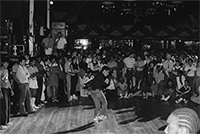
Dark Age (1986–1990)
Third Wave (1990–present)
Renaissance (1990–2000)
"We were at the very end of the golden era. You had hip hop at its zenith in terms of a Renaissance movement of the culture, of the skills, of the artforms." – Asia1, BBOY Summit 99 1999
"Breaking has experienced a massive renaissance in with popular culture in the last decade. However, during the 'dark ages,' the dance was sustained and cultivated regardless of (or in spite of) its relationship to popular cultural tastes." – Mary Fogarty, "'Whatever happened to breakdancing?': Transnational b-boy/b-girl networks, underground video magazines and imagined affinities" 2006
Modern Era (2000–present)
Footnotes
- There is disagreement over the name of the dance. However, "break dancing" is widely considered inadmissable (see Etymology and Definition). I have chosen to use "breaking" throughout this site over "b-boying and b-girling" only for conciseness.
- Today, burning and rocking refer to distinct dance styles. Both terms seem to have very different meanings among different people.
- Presumably, breakers would not always dance to the entire record, given that DJs (especially Flash) would sometimes play the break part of records exclusively, back to back. Herc also describes people "waiting" for the break, though this may refer to simply dancing less energetically.
